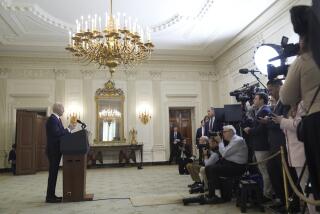Public Broadcasters Face âthe Fight of Our Livesâ
WASHINGTON â On the eve of a vote crucial to its financial health, the public television system is being buffeted by political and economic forces that have pushed it into a situation many say is one of the most precarious in its 38-year history.
The House of Representatives is considering a measure today that would nearly halve federal funding for public television -- a move that broadcasters predict would force the closure of small, rural stations and curtail production money for programming.
At the same time, the Corporation for Public Broadcasting, the private agency that distributes federal funds, is embroiled in a highly unusual partisan struggle involving allegations of secret contracts with Republican lobbyists and a consultant who graded former âNowâ host Bill Moyers on political bias. Meanwhile, PBS faces increased competition from the expanding world of cable, which offers the very history, arts and childrenâs programs that were once its sole domain. And its own prime-time audience, at an average age of 61, is nearing retirement.
The result is a period of high anxiety that rivals previous brawls over PBS, including then-House Speaker Newt Gingrichâs effort to eliminate all federal funding for public broadcasting in 1995.
âIn my opinion, this is probably the most tumultuous time that we have had,â said David Hosley, general manager of KVIE, Sacramentoâs public television station, who has worked in the field for 18 years. âThis is much more serious, much more divisive, and Iâm fearful that it may be more successful in harming Americaâs public broadcasting system.â
The measure before the House today would strip more than $200 million, including money for Ready to Learn, an initiative that helps finance childrenâs shows such as âReading Rainbow.â
Republican supporters say the cuts -- part of a large package of reductions in the Labor, Health and Human Services and Education appropriations bill -- were necessary to help overcome a $1.6-billion shortfall.
âChoices are easy when dollars are plentiful, but that was not the case this year,â Rep. Ralph Regula (R-Ohio), chairman of the subcommittee that approved the cuts, said in a statement.
But broadcasting officials hope they can head off the measure, either through a bipartisan amendment expected to be offered today that would restore $100 million to the CPB budget or later in the summer, when the Senate is expected to take up the measure.
As they lobby lawmakers to preserve their money, a partisan battle has overtaken the nonprofit corporation charged with distributing the federal funds to PBS, National Public Radio and local television and radio stations. At its center is Kenneth Y. Tomlinson, the Republican chairman of the board, who has sought to stamp out what he sees as a liberal bias.
The confluence of events has local station officials deeply concerned and fretting that the system is being torn apart by partisanship when it needs unity.
âThere definitely has been a period of demoralization,â said John Lawson, president of the Assn. of Public Television Stations. âI think the actions of Ken Tomlinson have been quite damaging. The controversy around them has hurt us in the eyes of the public and it has been a huge distraction.â
Tomlinson, former editor of Readerâs Digest, has maintained that he is seeking only to bring more balance to public broadcasting, thereby expanding its viewership and strengthening it in the process.
Paradoxically, the upheaval has galvanized the usually sedate world of public television and given local radio stations additional ammunition in their fundraising appeals.
Marshaled by spots on their local stations, people have flooded their local congressional offices with phone calls protesting the cuts. MoveOn.org gathered more than 1 million signatures in a week from opponents of the measure. And members of the CPB board said they had received thousands of e-mails from viewers weighing in on Tomlinsonâs actions.
âThe positive in all of this is it has provoked a public debate about public television, which I think is a healthy thing,â said Paula Kerger, chief operating officer of Thirteen/WNET in New York.
The struggles over public televisionâs finances and politics come amid continuing nervousness about what can be shown on the public airwaves.
Earlier this year, PBS President Pat Mitchell declined to distribute an episode of the childrenâs program âPostcards From Busterâ that featured a family with two lesbian moms, a show that came under criticism from Education Secretary Margaret Spellings. Weeks later, PBS sent member stations an edited version of a âFrontlineâ documentary about U.S. troops in Iraq that cut out the profanity used by soldiers.
âPublic television should be doing cutting-edge and daring things, and unfortunately we havenât done a lot of that lately,â said Bill Reed, president of KCPT in Kansas City, Mo. âI think weâve gotten a lot more cautious.â
Mitchell announced in February that she would leave her post when her contract expires in June 2006. She said the move was unrelated to the controversies, but acknowledged that the job has been more difficult than she thought it would be.
Despite the upheaval of the last six months, officials note that public television has had some success. With an average prime-time audience of 2.3 million people, PBS has lost viewership from five years ago but has seen an uptick in the last year, according to Nielsen Media Research, which PBS executives cite as evidence that the public still seeks noncommercial television.
Though it lags far behind the viewership of the large commercial networks, PBS, with a prime-time rating of 1.8, resoundingly beats the average prime-time audience of cable competitors such as A&E; and Discovery, which garner less than half of that. An average audience of more than 81 million people tunes into PBS stations every week.
âWhile there are a lot of different channel offerings, there still is no one using the media as a public service in the way that public broadcasting does,â said John F. Wilson, senior vice president for programming at PBS.
But that message has been overshadowed in recent months by activities at the CPB, where Tomlinson has pushed for more conservative voices in public broadcasting during his 21-month tenure. He has complained that Mitchell is âpolitically tone-deafâ about what he said was liberal bias in the âNowâ program when hosted by Moyers. And he has suggested that NPR has not been objective in its Middle East coverage.
The corporationâs inspector general is investigating Tomlinsonâs activities, including his hiring of a former White House official and giving of contracts to two GOP lobbyists.
Tomlinson has defended his actions, saying that he has worked only to improve public broadcasting. But critics, many of whom are Democrats, charge him with injecting partisanship into the very agency that is supposed to be a political buffer between Congress and PBS. On Tuesday, 16 Democratic senators sent President Bush a letter asking him to fire Tomlinson. The White House declined, reiterating its support for the chairman.
Tomlinson was appointed to the board in 2000 by President Clinton and reappointed three years later by Bush. His colleagues elected him chairman the same year.
Moyers -- who retired in December to write a book -- said Wednesday he believes the charged debate has had a chilling effect on PBS.
âSince the right has succeeded in demonizing me and politicizing this debate, thereâs a nervousness on the part of a lot of stations about carrying controversial programming, quite frankly,â he said in an interview on the radio program âDemocracy Now!â
Mitchell, also on Wednesday, called on the CPB chairman to demonstrate his commitment to public broadcasting by fighting the proposed budget cuts.
âWeâre in the fight of our lives now,â the PBS president said in a conference call with reporters. âAnd if, in fact, his goal has been -- as he has stated, and we take him at his word -- to broaden the base of our support, well, hereâs a chance to prove it and have a positive impact.â
Tomlinson said Tuesday that he would fight the cuts, which caught public broadcasters by surprise when they were approved by a House subcommittee earlier in the month.
A spokeswoman said Regula, the chairman of that subcommittee, was not available for an interview because of a busy voting schedule. Unlike 1995, when GOP leaders made an ideological argument to eliminate federal financing for public broadcasting, Republicans have been quiet about this yearâs measure.
Although the cuts would slash the federal funds for local television and radio stations, NPR enjoys a financial cushion, a bequest of more than $200 million made in 2003 by the late Joan Kroc, who was married to McDonaldâs founder Ray Kroc. It and its member stations also benefit from an expanding, upscale audience -- 26.1 million weekly, double its size seven years ago -- that supports local fundraising drives.
The measure going to the House is raising concern for PBS. It calls for eliminating money that would help stations convert to digital broadcasting and upgrade the PBS satellite.
Broadcasters say stations in rural, poorer areas of the country are most vulnerable.
âIt could mean the end of public broadcasting for our station in upper Michigan,â said Eric Smith, general manager of WNMU in Marquette, which relies on CPB for half its revenues.
New Yorkâs Thirteen/WNET, which produces one-third of the prime-time PBS schedule, says it would have to curtail its production of new shows and seek projects that would appeal to private underwriters.
On Wednesday, public broadcasting allies remained cautiously optimistic that the cuts could be averted. Reps. David Obey (D-Wis.), Nita Lowey (D-N.Y.) and James Leach (R-Iowa) planned to offer an amendment to restore $100 million.
âI truly do not believe that there is much enthusiasmâ for the cuts, said Rep. Earl Blumenauer (D-Ore.), co-chairman of the Congressional Public Broadcasting Caucus.
*
(BEGIN TEXT OF INFOBOX)
[Please see microfilm for full chart information]
*
Public broadcastingâs woes
The federal government provides the annual budget for the Corporation for Public Broadcasting, which distributes funds to local stations. That funding makes up 15% of total public broadcasting revenues. However, some rural stations rely on federal funds for up to 85% of their budgets.
Federal funding for CPB
For fiscal years, in millions
2006: $400 million (Without proposed cuts)
*
Proposed cuts for 2006
From the $400 million CPB appropriation:
- $100 million
From other federal budget line items:
- $23.4 million Ready to Learn program (provides funding for programs such as âSesame Street,â âReading Rainbowâ and âPostcards from Busterâ)
- $39 million to help TV stations convert to digital systems
- $40 million to upgrade PBSâ satellite systems.
*
Change in prime-time ratings
(October 2000 to March 2001 compared with October 2004 to March 2005)
Basic cable: +27%
Pay cable: -12%
Four major networks: -13
Public television: -14
Other broadcast networks: -23
Sources: Corporation for Public Broadcasting; Assn. for Public Television Stations Nielsen Media Research
*
Los Angeles Times
More to Read
The biggest entertainment stories
Get our big stories about Hollywood, film, television, music, arts, culture and more right in your inbox as soon as they publish.
You may occasionally receive promotional content from the Los Angeles Times.










